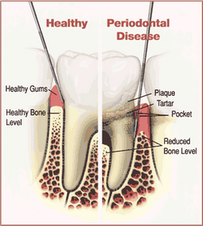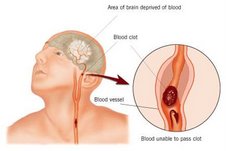Article 1:
The association of gingivitis and periodontitis with ischemic stroke
303 patients examined within 2 days of stroke occurring
Study found that on average the patients recovering from stroke had greater percentages of bone loss, probe depths, and clinical attachment loss than the controlled population.
Periodontitis was associated with 4 times higher odds ratio for stroke, than a status with out periodontitis and a 3 times higher odd of bone loss greater that 2.5 mm.
Article 2:
Early carotid atherosclerosis in subjects with periodontal diseases
82 perio and 31 healthy patients were randomly chosen in 1985 and given clinical oral examination. 16 years later atherosclerotic risk factor analysis was performed. Common carotid artery and lumen diameter were measured and calculated.
Study identified periodontal disease as a risk factor in the development of early atherosclerotic vascular lesions.
Article 3:
Association of periodontal conditions and systemic disease in older subjects
Study took random sample of 1,084 subjects between ages 60-75
Study found link between the bacteria that causes periodontal disease to increase the risk of atherosclerosis and cardiovascular diseases.
Study found that the highest odds ratio of a association between periodontitis and cardiovascular disease is for stroke.
Bibliography:
Christof, Dorfer, et al. “The Association of gingivitis and periodontitis with ischemic stroke.” Journal of Clinical Periodontology, June 2004; 31: 396-401
Soder, Per-Osten et al. "Early Carodtid Atherosclerosis in Subjects With Periodontal Diseases." American Heart Association, Inc.
Persson RE, Hollender LG, Powell VL, MacEntee M, Wyatt CCL, Kiyak HA, Persson GR. “Assessment of Periodontal Conditions and Systemic Disease in Older Subjects. II. Focus on Cardiovascular Disease.” Journal of Clinical Periodontology 2002; 29: 803-8
We've also worked on the IRB application. It was a little confusing, so we hope that all of the necessary information is in here:
A. APPLICATION FORM
The application form must be filled out completely so committee members may have a clear understanding of the nature and human subject implications of the research proposal. A summary paragraph for each section is sufficient. A statement referring to the attached material is not sufficient and will not be accepted. Applications submitted with incomplete forms will be returned without consideration of the proposal.
1. TITLE
Putting Theory into Practice: A Community Assessment of
Knowledge and Plan for Intervention
2. DESCRIPTION OF THE STUDY
As students we were concerned about the correlation between stroke and periodontal disease and wondered if the general public was aware of this correlation. After community health, we thought it would be great to put the ADPIE (assess, diagnose, plan, implementation and evaluation) model into practice for the purpose of informing the public.
So what? This is important for us to address at this time because we are concerned about community health issues.
Our research purpose is to follow the ADPIE model to put theory into practice and see if, as students, this model does indeed scaffold for us a way to assess and meet a community need. Guiding research questions for the assessment phase are:
Does the public know what periodontal disease is?
Can the public articulate the harmful effects periodontal disease has not only on the mouth, but the entire body?
Is the general public aware of the correlation between periodontal disease and stroke?
3. DURATION OF THE STUDY
1 year, unless another group of students would like to continue our research.
4. MULTICENTER STUDY
There will be no other participants at this time.
5. NUMBERS OF SUBJECTS
There will be 300 subjects, randomly selected to take a survey.
6. HEALTH STATUS OF THE SUBJECTS
The subjects will be generally healthy, but we will not exclude any participants based on their health status.
7. SUBJECT GROUPS EXCLUDED
No groups will be excluded.
8. AGES OF THE SUBJECTS
No subjects under the age of 18 will be asked to participate in the study.
9. DESIGN OF THE STUDY
Single shot 10 question survey of general population with nonparametric data. Data will be assessed with descriptive and inferential statistics.
10. RISKS TO SUBJECTS
There will be no risk to subjects. They will not be asked to disclose their name or contact information.
ANY MODERATE OR HIGH RISK STUDY MUST GO THROUGH A SEPARATE REVIEW PROCEDURE WHICH INCLUDES THE APPROPRIATE ADMINISTRATIVE OFFICER AND THE UNIVERSITY ATTORNEY.
BENEFITS TO SUBJECTS AND OTHERS
Hopeful benefits of the research will be that the participants will gain a greater knowledge on periodontal disease and stroke. As an incentive to complete the survey subjects will be offered a free toothbrush.
11. COSTS TO BE BORNE BY SUBJECTS
There will be no cost monetarily to subjects. Just their time will be required. (3-5 minutes)
12. IS CONFIDENTIALITY ASSURED
A. We will conduct a convenient sample with randomly selected participants from 3 different locations. A statement will be on the top of the survey explaining to the participants that by completing the survey, they give consent and their answers and identity will be kept confidential.
B. No information on the subjects will be taken. They will be asked their sex, and age range. Their names will not be asked for and only we, the conductors of the survey will see their answers. After recording the data, the surveys will be carefully disposed of.
13. CONTRACT OR GRANT NUMBER
Include the contract or grant number, sponsoring agency, and/or granting agency.
14. NAME OF PRINCIPAL INVESTIGATOR AND DEPARTMENT
Include the names of all the investigators, signatures, mailing addresses, telephone numbers, University Department, and Department Chair’s name.
B. DESCRIPTION OF THE STUDY
This should be brief (no longer than two pages) and should include:
1. BACKGROUND INFORMATION
Through research, we have discovered there is a strong correlation that people with periodontal disease are more likely to have a stroke, than those who don’t. As students, we were unaware of this correlation and believe that the general public is also unaware, so we would like to inform them about the dangers of periodontal disease, to not only the mouth but to the whole body. By doing a survey, we hope to gain insight as to whether there is a need to educate the public about periodontal disease, and to learn how much, if anything most people already know about the subject.
2. EXPERIMENTAL METHODS
Non experimental study, survey, population and then implementation non-invasive adult pop again
3. DESCRIPTION OF RECRUITMENT PROCEDURES
Convenience sample from 3 different locations, participants chosen randomly.
4. MODERATE OR HIGH RISK
No risk to participants
PRENHALL/NATHE WEBSITE
Today we also went on to do some research on the prenhall/nathe website to see what kind of information that we could find. It is a very interesting and helpful website for many different things from research to studying for boards.
The links they have on the website are the following:
-American Dental Hygienists' Association
The professional organization representing American dental hygienists
-American Association of Public Health Dentistry
The professional organization representing American dental hygienists and dentists working in public health
-International Federation of Dental Hygienists
The professional organization representing dental hygienists around the world
-World Health Organization
The international organization of health
-Hispanic Dental Association
The professional organization of dental hygienists and dentists representing the Hispanic population and underserved populations in America
-American Association of State and Territorial Dental Directors
American State and Territorial Dental Directors
-American Department of Health and Human Services
The United States Department of Health and Human Services
-University of New Mexico, Division of Dental Hygiene
The University of New Mexico, Division of Dental Hygiene website
-Federation Dentaire International
The professional organization representing dentists around the world
-American Dental Association
The professional organization representing American dentists
-American Public Health Association
The professional organization representing American public health professionals
-American Dental Educator's Association
The professional organization representing American dental hygiene, dental, and dental assisting educators
-International Association of Dental Researchers
The professional association representing dental researchers around the world
-Sigma Phi Alpha
The international dental hygiene honor society
-United States Peace Corps
The website for information on the United States Peace Corps
-U.S. Department of Health and Human Services
The website for the US Department of Health and Human Services and links to other governmental agencies.
None of the websites that we visited such as the ADA, ADHA, or the ADEA website had any informatiion that we could find on the topic of stroke and perio, which modivated us to get do our research so the down the road there will be information on stroke and perio on important websites like these. The word isn't out there like it needs to be.
We found one particular thing very interesting on the prenhall website, the powerpoint titled, Community Groups: Making a Connection. It was very interesting because it touched on many connections between oral health and the overall health of the body, but in specific it discussed stroke and perio.
Another interesting link on the website was to the New York Times. Prentice Hall has partnered with The College Times, a new site from NYTimes.com, to provide you with the latest news on selected disciplines.
It has a place where you can "click here" and it will take you directly to the latest information related to Dentistry and Public Health.
Students and faculty can access a number of additional resources, including career planning information for students and instructional resources for faculty. In addition, students and faculty can also sign up to receive free e-mail alerts when new articles related to their specific areas of study are published on NYTimes.com.
The website was interesting and fun to look at the information on the website and go to the links to other pages that were also useful. We are excited to be able to turn to this website for questions that we might have along the way or for research on our topic.
Group Hours:
NRH Information and Quiz: 3 Hours
Mtg with Kami 5/9: 2 Hours
Research on prenhall/Nathe: 2 Hours
Group mtg (survey, IRB, research) 5/16: 3 Hours


No comments:
Post a Comment